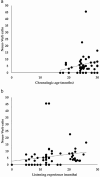Expressive vocabulary word categories of children who are deaf and hard-of-hearing
- PMID: 38240124
- PMCID: PMC11195470
- DOI: 10.1093/deafed/enad066
Expressive vocabulary word categories of children who are deaf and hard-of-hearing
Abstract
This study investigated the acquisition of early expressive vocabulary among young children who are deaf and hard-of-hearing (DHH; n = 68) using auditory technology (hearing aids and cochlear implants). Parents completed a standardized vocabulary checklist, which allowed analyses of (i) the size of their child's spoken vocabulary; (ii) composition of the expressive lexicon (e.g., parts of speech such as nouns and verbs; semantic categories such as routines and body parts); and (iii) demographic and audiologic factors (e.g., chronologic age, degree of hearing access) potentially associated with these metrics. Young children who are DHH and use auditory technology acquired fewer spoken words than peers with typical hearing (TH) matched for chronologic age but more spoken words than peers with TH matched for listening experience. Action verbs-not nouns-significantly increased the odds of a child who is DHH achieving a vocabulary quotient within the normative range. These findings support the exploration of early expressive vocabulary size and composition-especially the number of active verbs-to guide clinical management and decision-making for young children who are DHH.
Keywords: deaf; early childhood; hard of hearing; listening technology; vocabulary.
© The Author(s) 2024. Published by Oxford University Press. All rights reserved. For permissions, please email: journals.permissions@oup.com.
Conflict of interest statement
Sean Anderson is also employed by Cochlear Ltd and helped with the statistical analysis. We have no other conflicts of interest to disclose.
Figures







References
-
- Bouton, S., Colé, P., & Serniclaes, W. (2012). The influence of lexical knowledge on phoneme discrimination in deaf children with cochlear implants. Speech Commun, 54(2), 189–198. 10.1016/j.specom.2011.08.002. - DOI
MeSH terms
Grants and funding
LinkOut - more resources
Full Text Sources
Medical

